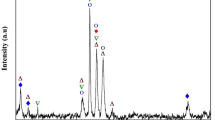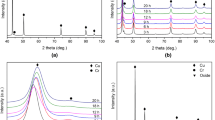Abstract
The ultrafine-grained microstructures and functional properties, including wear resistance for dry sliding and electrical conductivity, were investigated in a Cu–0.3 %Cr–0.5 %Zr alloy processed by equal-channel angular pressing (ECAP) at a temperature of 400 °C to total strains of 1, 2, and 4. Severe plastic deformation by ECAP to a total strain of ~1 led to a significant decrease in the wear resistance because of the rapid surface damage to both solution-treated (ST) and aged (AT) samples where a high density of dislocations was arranged in stochastic low-angle subboundaries by brittle fracture. Further deformation by subsequent ECAP passes promoted the subdivision of the shear bands by geometrically necessary boundaries. Correspondingly, the number of fine crystallites outlined by high-angle boundaries increased, and the wear rate decreased. After four ECAP passes, the wear rate decreased to the level of the initial state of the alloy and equaled 1.68 × 10−5 mm3/(N m) and 1.40 × 10−5 mm3/(N m) for ST and AT samples, respectively. The results demonstrate that the damage mechanism is the controlling factor for wear resistance of Cu–Cr–Zr bronze hardened by intense plastic straining.




Similar content being viewed by others
References
Topuz AI (2015) Enabling microstructural changes of FCC/BCC alloys in 2D dislocation dynamics. Mater Sci Eng A 627:381–390
Correia JB, Davies HA, Sellars CM (1997) Strengthening in rapidly solidified age hardened Cu–Cr and Cu–Cr–Zr alloys. Acta Mater 45:177–190
ITER Joint Central Team (1994) The impact of materials selection on the design of the International Thermonuclear Experimental Reactor (ITER). J Nucl Mater 212–215:3–10
Liu Q, Zhang X, Ge Y, Wang J, Cui JZ (2006) Effect of processing and heat treatment on behavior of Cu–Cr–Zr alloys to railway contact wire. Metal Mater Trans A 37:3233–3238
Batra IS, Dey GK, Kulkarni UD, Banerjee S (2001) Microstructure and properties of a Cu–Cr–Zr alloy. J Nucl Mater 299:91–100
Ghosh G, Miyake J, Fine ME (1997) The systems-based design of high strength, high-conductivity alloys. JOM 49:56–60
Archard JF (1953) Contact and rubbing of flat surfaces. J Appl Phys 24:981–988
Archard JF, Hirst W (1956) The wear of metals under unlubricated conditions. Proc Royal Soc A 236:397–410
Zhilyaev AP, Gimazov AA, Langdon TG (2013) Recent developments in modelling of microhardness saturation during SPD processing of metals and alloys. J Mater Sci 48:4461–4466. doi:10.1007/s10853-013-7155-6
Zhilyaev AP, Swaminathan S, Pshenichnyuk AI, Langdon TG, McNelley TR (2013) Adiabatic heating and the saturation of grain refinement during SPD of metals and alloys: experimental assessment and computer modelling. J Mater Sci 48:4626–4636. doi:10.1007/s10853-013-7254-4
Belyakov A, Murayama M, Sakai Y, Tsuzaki K, Okubo M, Eto M, Kimura T (2006) Development of a high-strength high-conductivity Cu–N–P alloy. Part II: processing by severe deformation. J Electr Mater 35:2000–2008
Wei KX, Wei W, Wang F, Dua QB, Alexandrov IV, Hu J (2011) Microstructure, mechanical properties and electrical conductivity of industrial Cu–0.5% Cr alloy processed by severe plastic deformation. Mater Sci Eng A 528:1478–1484
Vinogradov A, Patlan V, Suzuki Y, Kitagawa K, Kopylov VI (2002) Structure and properties of ultra-fine grain Cu–Cr–Zr alloy produced by equal-channel angular pressing. Acta Mater 50:1639–1651
Shakhova I, Yanushkevich Z, Fedorova I, Belyakov A, Kaibyshev R (2014) Grain refinement in a Cu–Cr–Zr alloy during multidirectional forging. Mater Sci Eng A 606:380–389
Murashkin MY, Sabirov I, Sauvage X, Valiev RZ (2016) Nanostructured Al and Cu alloys with superior strength and electrical conductivity. J Mater Sci 51:33–49. doi:10.1007/s10853-015-9354-9
Zhilyaev AP, Shakhova I, Belyakov A, Kaibyshev R, Langdon TG (2014) Effect of annealing on wear resistance and electroconductivity of copper processed by high-pressure torsion. J Mater Sci 49:2270–2278. doi:10.1007/s10853-013-7923-3
Shangina D, Maksimenkova Y, Bochvar N, Serebryany V, Raab G, Vinogradov A, Skrotzki W, Dobatkin S (2016) Influence of alloying with hafnium on the microstructure, texture, and properties of Cu–Cr alloy after equal channel angular pressing. J Mater Sci 51:5493–5501. doi:10.1007/s10853-016-9854-2
Chbihi A, Sauvage X, Blavette D (2014) Influence of plastic deformation on the precipitation of Cr in copper. J Mater Sci 49:6240–6247. doi:10.1007/s10853-014-8348-3
Shangina DV, Gubicza J, Dodony E, Bochvar NR, Straumal PB, Tabachkova NY, Dobatkin SV (2014) Improvement of strength and conductivity in Cu-alloys with the application of high pressure torsion and subsequent heat-treatments. J Mater Sci 49:6674–6681. doi:10.1007/s10853-014-8339-4
Mishnev R, Shakhova I, Belyakov A, Kaibyshev R (2015) Deformation microstructures, strengthening mechanisms, and electrical conductivity in a Cu–Cr–Zr alloy. Mater Sci Eng A 629:29–40
Zhilyaev AP, Shakhova I, Morozova A, Belyakov A, Kaibyshev R (2016) Grain refinement kinetics and strengthening mechanisms in Cu–0.3Cr–0.5Zr alloy subjected to intense plastic deformation. Mater Sci Eng A 654:131–142
Rigney DA, Glaeser WA (1978) The significance of near surface microstructure in the wear process. Wear 45:241–250
Zhilyaev AP, Shakhova I, Belyakov A, Kaibyshev R, Langdon TG (2013) Wear resistance and electroconductivity in copper processed by severe plastic deformation. Wear 305:89–99
Iwahashi Y, Wang J, Horita Z, Nemoto M, Langdon TG (1996) Principle of equal-channel angular pressing for the processing of ultrafine-grained materials. Scripta Mater 35:143–146
Furukawa M, Iwahashi Y, Horita Z, Nemoto M, Langdon TG (1998) The shearing characteristics associated with equal-channel angular pressing. Mater Sci Eng A 257:328–332
Acknowledgements
AM and RK acknowledge financial support from the Ministry of Science and Education, Russia, under Grant No. 14.Y31.16.8446-NSH and APZ acknowledges a TECNIOSPRING grant financed by Generalitat de Catalunya and co-funded by the 7th Framework program of the EU and the Russian Science Foundation (Project 14-29-00199). TGL acknowledges support from the European Research Council under ERC Grant Agreement No. 267464-SPDMETALS.
Author information
Authors and Affiliations
Corresponding author
Ethics declarations
Conflict of Interest
The authors declare that they have no conflict of interest.
Rights and permissions
About this article
Cite this article
Zhilyaev, A.P., Morozova, A., Cabrera, J.M. et al. Wear resistance and electroconductivity in a Cu–0.3Cr–0.5Zr alloy processed by ECAP. J Mater Sci 52, 305–313 (2017). https://doi.org/10.1007/s10853-016-0331-8
Received:
Accepted:
Published:
Issue Date:
DOI: https://doi.org/10.1007/s10853-016-0331-8




